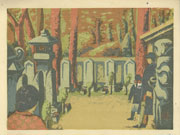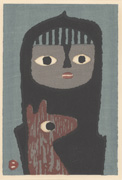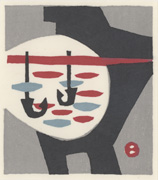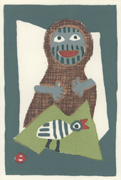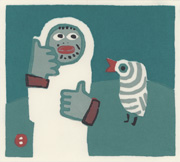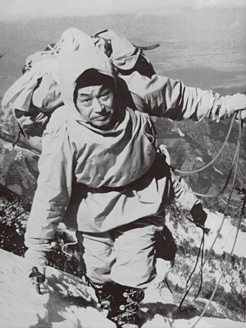Prints in Collection
Scenes of Last Tokyo, 1945
Repose, 1963
IHL Cat. #1332
| Child and Dog, c. 1970s-1980s IHL Cat. #938 | Ice Fishing, after 1980 IHL Cat. #1329 | Smiling Mountain Man, after 1980 IHL Cat. #1330 | Mountain Man, after 1980 IHL Cat. #1331 |
Azechi Umetarō (畦地梅太郎, 1902-1999) was born to an impoverished farming family in Ehime prefecture on remote Shikoku Island on December 28, 1902. To make ends meet, Azechi’s father carved masks for village festivals and Azechi would later comment that he inherited his father’s craftsmanship. At the age of 16, unwilling to take up farming and with his father’s approval, he decided to try his luck in Tokyo. Stopping in Osaka to see his older brother, his ill-defined plans to move to Tokyo were derailed by his brother’s insistence that he first earn some money. Serving for eighteen months as a cabin boy on a freighter, he would not see Tokyo until the age of eighteen.
Arriving in Tokyo, Azechi held various jobs, including delivering newspapers. It was his newspaper route that brought him in contact with an art student who he saw painting one morning, and Oliver Statler reported that “it struck Azechi that here was a fascinating occupation. He fell in love, not with art, but with the idea of being an artist.” He proceeded to enroll in an art correspondence course and thought of attending a private art school, but lack of funds and a call for induction in the army stopped his art education. Returning to Shikoku for induction, he was rejected by the army for being too short. He returned to Tokyo in 1923 in time to experience the horrific 1923 Great Kanto Earthquake which forced him to return home again. Back home he tried farming, hated it, and misrepresenting himself as an experienced oil painter, was hired as a poster painter for a movie theater. In 1925, after two years in Shikoku and even more determined to become an artist, he returned to Tokyo where he was hired, through a friend, in a government printing plant.
While at the printing plant, he began making prints by scratching out designs on lead plates, inking them and using a teacup as a baren. An acquaintance at the printing office suggested he visit the prominent sōsaku hanga woodblock artist Hiratsuka Un'ichi (1895-1997). Hiratsuka saw potential in Azechi’s lead plate prints and encouraged him to submit work to the Japan Print Association exhibition. Hiratsuka also encouraged Azechi to switch from lead plates to wood blocks for his prints.
In Azechi's words:
In those days, anyone submitting prints for the exhibition took them to Koshiro Onchi’s home [Onchi Kōshirō (1891-1955)], for Onchi was the guiding spirit of the Association. I went there, and the man who answered the door was Gen Yamaguchi [Yamaguchi Gen (1896-1976). That was when he was serving a sort of discipleship to Onchi and helping as handyman during the exhibitions. So the first print artist I met was Hiratsuka, the second Yamaguchi, and the third, Onchi. All became my friends.
Experiencing success at the JPA exhibition he went on to exhibit at both the Kokuga-kai and the Shunyo-kai.
He would soon quit his job at the printing office to lead the life of a free-lance artist earning his living, in part, by carving woodblocks for other artists such as Onchi, Hiratsuka and Maekawa Senpan (1888-1960).
While Hiratsuka was instrumental in getting Azechi to switch from lead plate to wood blocks, it is Onchi who Azechi credits for putting him on the path that made him famous – his prints of mountains and mountaineers. Onchi advised him to think “about the meaning and function of art and the artist” and "to search for the essence of his own experience and to trust his innermost feelings." This search brought him back to his boyhood in Ehime and his love for the mountains and their people and set the focus of his life’s work – the mountains he remembered from his childhood, the yama-otoko, men of the mountains, and his love of climbing.
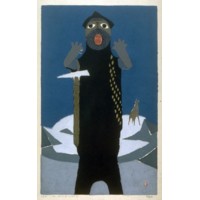
I'm grateful to Hiratsuka for his initial encouragement and his steady support all through the years. Maybe without him I wouldn't be an artist today. As for my work, the greatest influence was Onchi [Onchi Koshiro (1891-1955)], and my simplified style today owes most to him - Azechi Umetarō
 |
My roots are in the Country, and I like simple rustic work… I respect (Shikō) Munakata’s approach, and I agree with him that Japanese artists imitate too much. In my own case I think my lack of training saves me from that kind of thing.2 - Azechi Umetarō
2 blog of Glenn Hernandez http://www.funomena.com/blog/2014/12/drawing-inspiration-from-the-life-and-work-of-umetaro-azechi
